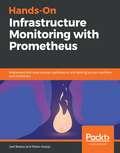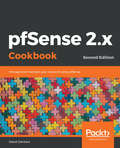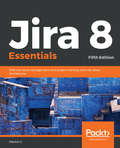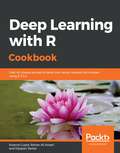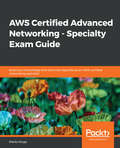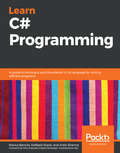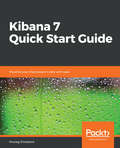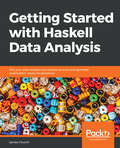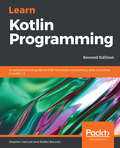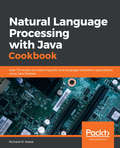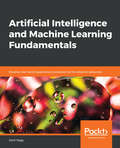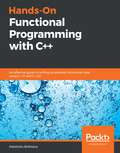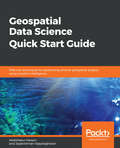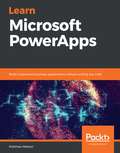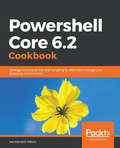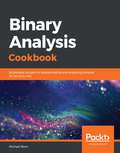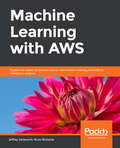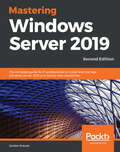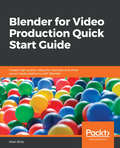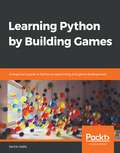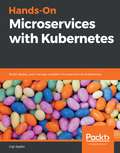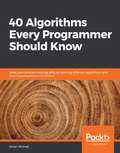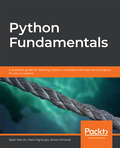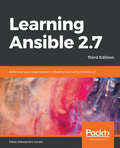- Table View
- List View
Hands-On Infrastructure Monitoring with Prometheus: Implement and scale queries, dashboards, and alerting across machines and containers
by Joel Bastos Pedro AraújoBuild Prometheus ecosystems with metric-centric visualization, alerting, and queryingKey FeaturesIntegrate Prometheus with Alertmanager and Grafana for building a complete monitoring systemExplore PromQL, Prometheus' functional query language, with easy-to-follow examplesLearn how to deploy Prometheus components using Kubernetes and traditional instancesBook DescriptionPrometheus is an open source monitoring system. It provides a modern time series database, a robust query language, several metric visualization possibilities, and a reliable alerting solution for traditional and cloud-native infrastructure.This book covers the fundamental concepts of monitoring and explores Prometheus architecture, its data model, and how metric aggregation works. Multiple test environments are included to help explore different configuration scenarios, such as the use of various exporters and integrations. You’ll delve into PromQL, supported by several examples, and then apply that knowledge to alerting and recording rules, as well as how to test them. After that, alert routing with Alertmanager and creating visualizations with Grafana is thoroughly covered. In addition, this book covers several service discovery mechanisms and even provides an example of how to create your own. Finally, you’ll learn about Prometheus federation, cross-sharding aggregation, and also long-term storage with the help of Thanos.By the end of this book, you’ll be able to implement and scale Prometheus as a full monitoring system on-premises, in cloud environments, in standalone instances, or using container orchestration with Kubernetes.What you will learnGrasp monitoring fundamentals and implement them using PrometheusDiscover how to extract metrics from common infrastructure servicesFind out how to take full advantage of PromQLDesign a highly available, resilient, and scalable Prometheus stackExplore the power of Kubernetes Prometheus OperatorUnderstand concepts such as federation and cross-shard aggregationUnlock seamless global views and long-term retention in cloud-native apps with ThanosWho this book is forIf you’re a software developer, cloud administrator, site reliability engineer, DevOps enthusiast or system admin looking to set up a fail-safe monitoring and alerting system for sustaining infrastructure security and performance, this book is for you. Basic networking and infrastructure monitoring knowledge will help you understand the concepts covered in this book.
pfSense 2.x Cookbook - Second Edition: Manage and maintain your network using pfSense, 2nd Edition
by David ZientaraThis book is intended for all levels of network administrators. If you are an advanced user of pfSense, then you can flip to a particular recipe and quickly accomplish the task at hand, while if you are new to pfSense, you can read chapter by chapter and learn all of the features of the system from the ground up.
Jira 8 Essentials - Fifth Edition: Effective Issue Management And Project Tracking With The Latest Jira Features, 5th Edition
by Patrick LiThis book will be especially useful for project managers but it's also intended for other Jira users, including developers, and any other industry besides software development, who would like to leverage Jira's powerful task management and workflow features to better manage their business processes.
Deep Learning with R Cookbook: Over 45 unique recipes to delve into neural network techniques using R 3.5.x
by Dipayan Sarkar Swarna Gupta Rehan Ali AnsariTackle the complex challenges faced while building end-to-end deep learning models using modern R libraries Key Features Understand the intricacies of R deep learning packages to perform a range of deep learning tasks Implement deep learning techniques and algorithms for real-world use cases Explore various state-of-the-art techniques for fine-tuning neural network models Book Description Deep learning (DL) has evolved in recent years with developments such as generative adversarial networks (GANs), variational autoencoders (VAEs), and deep reinforcement learning. This book will get you up and running with R 3.5.x to help you implement DL techniques. The book starts with the various DL techniques that you can implement in your apps. A unique set of recipes will help you solve binomial and multinomial classification problems, and perform regression and hyperparameter optimization. To help you gain hands-on experience of concepts, the book features recipes for implementing convolutional neural networks (CNNs), recurrent neural networks (RNNs), and Long short-term memory (LSTMs) networks, as well as sequence-to-sequence models and reinforcement learning. You'll then learn about high-performance computation using GPUs, along with learning about parallel computation capabilities in R. Later, you'll explore libraries, such as MXNet, that are designed for GPU computing and state-of-the-art DL. Finally, you'll discover how to solve different problems in NLP, object detection, and action identification, before understanding how to use pre-trained models in DL apps. By the end of this book, you'll have comprehensive knowledge of DL and DL packages, and be able to develop effective solutions for different DL problems. What you will learn Work with different datasets for image classification using CNNs Apply transfer learning to solve complex computer vision problems Use RNNs and their variants such as LSTMs and Gated Recurrent Units (GRUs) for sequence data generation and classification Implement autoencoders for DL tasks such as dimensionality reduction, denoising, and image colorization Build deep generative models to create photorealistic images using GANs and VAEs Use MXNet to accelerate the training of DL models through distributed computing Who this book is for This deep learning book is for data scientists, machine learning practitioners, deep learning researchers and AI enthusiasts who want to learn key tasks in deep learning domains using a recipe-based approach. A strong understanding of machine learning and working knowledge of the R programming language is mandatory.
AWS Certified Advanced Networking - Specialty Exam Guide: Build your knowledge and technical expertise as an AWS-certified networking specialist
by Marko SlugaDevelop technical skills and expertise to automate AWS networking tasksKey FeaturesA fast paced guide that will help you pass the exam with confidenceLearn advanced skill sets to build effective AWS networking solutions Enhance your AWS skills with practice exercises and mock testsBook DescriptionAmazon has recently come up a with specialty certifications which validates a particular user's expertise that he/she would want to build a career in. Since the Cloud market now demands of AWS networking skills this becomes the most wanted certification to upheld ones industry portfolio. This book would be your ideal companion to getting skilled with complex and creative networking solutions. Cloud practitioners or associate-level certified individuals interested in validating advanced skills in networking can opt for this practical guide.This book will include topics that will help you design and implement AWS and hybrid IT network architectures along with some network automation tasks. You will also delve deep into topics that will help you design and maintain network architecture for all AWS services. Like most of our certification guides this book will also follow a unique approach of testing your learning with chapter-level practice exercises and certification-based mock tests. The exam mock tests will help you gauge whether you are ready to take the certification exam or not. This book will also be an advanced guide for networking professionals to enhance their networking skills and get certified. By the end of this book, you will be all equipped with AWS networking concepts and techniques and will have mastered core architectural best practices.What you will learnFormulate solution plans and provide guidance on AWS architecture best practicesDesign and deploy scalable, highly available, and fault-tolerant systems on AWSIdentify the tools required to replicate an on-premises network in AWSAnalyze the access and egress of data to and from AWSSelect the appropriate AWS service based on data, compute, database, or security requirementsEstimate AWS costs and identify cost control mechanismsWho this book is forIf you are a system administrator, or a network engineer interested in getting certified with an advanced Cloud networking certification then this book is for you. Prior experience in Cloud administration and networking would be necessary.
Learn C# Programming: A guide to building a solid foundation in C# language for writing efficient programs
by Dino Esposito Marius Bancila Ankit Sharma Raffaele RialdiGet started with C# and strengthen your knowledge of core programming concepts such as procedural, object-oriented, generic, functional, and asynchronous programming along with the latest features of C# 8 Key Features Learn the fundamentals of C# with the help of easy-to-follow examples and explanations Leverage the latest features of C# 8, including nullable reference types, pattern matching enhancements, and asynchronous streams Explore object-oriented programming, functional programming, and multithreading concepts Book Description The C# programming language is often developers' primary choice for creating a wide range of applications for desktop, cloud, and mobile. In nearly two decades of its existence, C# has evolved from a general-purpose, object-oriented language to a multi-paradigm language with impressive features. This book will take you through C# from the ground up in a step-by-step manner. You'll start with the building blocks of C#, which include basic data types, variables, strings, arrays, operators, control statements, and loops. Once comfortable with the basics, you'll then progress to learning object-oriented programming concepts such as classes and structures, objects, interfaces, and abstraction. Generics, functional programming, dynamic, and asynchronous programming are covered in detail. This book also takes you through regular expressions, reflection, memory management, pattern matching, exceptions, and many other advanced topics. As you advance, you'll explore the .NET Core 3 framework and learn how to use the dotnet command-line interface (CLI), consume NuGet packages, develop for Linux, and migrate apps built with .NET Framework. Finally, you'll understand how to run unit tests with the Microsoft unit testing frameworks available in Visual Studio. By the end of this book, you'll be well-versed with the essentials of the C# language and be ready to start creating apps with it. What you will learn Get to grips with all the new features of C# 8 Discover how to use attributes and reflection to build extendable applications Utilize LINQ to uniformly query various sources of data Use files and streams and serialize data to JSON and XML Write asynchronous code with the async-await pattern Employ .NET Core tools to create, compile, and publish your applications Create unit tests with Visual Studio and the Microsoft unit testing frameworks Who this book is for If you have little experience in coding or C# and want to learn the essentials of C# programming to develop powerful programming techniques, this book is for you. It will also help aspiring programmers to write scripts or programs to accomplish specific tasks.
Kibana 7 Quick Start Guide: Visualize your Elasticsearch data with ease
by Anurag SrivastavaA quick start guide to visualize your Elasticsearch data Key Features Your hands-on guide to visualizing the Elasticsearch data as well as navigating the Elastic stack Work with different Kibana plugins and create effective machine learning jobs using Kibana Build effective dashboards and reports without any hassle Book Description The Elastic Stack is growing rapidly and, day by day, additional tools are being added to make it more effective. This book endeavors to explain all the important aspects of Kibana, which is essential for utilizing its full potential. This book covers the core concepts of Kibana, with chapters set out in a coherent manner so that readers can advance their learning in a step-by-step manner. The focus is on a practical approach, thereby enabling the reader to apply those examples in real time for a better understanding of the concepts and to provide them with the correct skills in relation to the tool. With its succinct explanations, it is quite easy for a reader to use this book as a reference guide for learning basic to advanced implementations of Kibana. The practical examples, such as the creation of Kibana dashboards from CSV data, application RDBMS data, system metrics data, log file data, APM agents, and search results, can provide readers with a number of different drop-off points from where they can fetch any type of data into Kibana for the purpose of analysis or dashboarding. What you will learn Explore how Logstash is configured to fetch CSV data Understand how to create index patterns in Kibana Become familiar with how to apply filters on data Discover how to create ML jobs Explore how to analyze APM data from APM agents Get to grips with how to save, share, inspect, and edit visualizations Understand how to find an anomaly in data Who this book is for Kibana 7 Quick Start Guide is for developers new to Kibana who want to learn the fundamentals of using the tool for visualization, as well as existing Elastic developers.
Getting Started with Haskell Data Analysis: Put your data analysis techniques to work and generate publication-ready visualizations
by James ChurchPut your Haskell skills to work and generate publication-ready visualizations in no time at allKey FeaturesTake your data analysis skills to the next level using the power of HaskellUnderstand regression analysis, perform multivariate regression, and untangle different cluster varietiesCreate publication-ready visualizations of dataBook DescriptionEvery business and organization that collects data is capable of tapping into its own data to gain insights how to improve. Haskell is a purely functional and lazy programming language, well-suited to handling large data analysis problems. This book will take you through the more difficult problems of data analysis in a hands-on manner.This book will help you get up-to-speed with the basics of data analysis and approaches in the Haskell language. You'll learn about statistical computing, file formats (CSV and SQLite3), descriptive statistics, charts, and progress to more advanced concepts such as understanding the importance of normal distribution. While mathematics is a big part of data analysis, we've tried to keep this course simple and approachable so that you can apply what you learn to the real world.By the end of this book, you will have a thorough understanding of data analysis, and the different ways of analyzing data. You will have a mastery of all the tools and techniques in Haskell for effective data analysis.What you will learnLearn to parse a CSV file and read data into the Haskell environmentCreate Haskell functions for common descriptive statistics functionsCreate an SQLite3 database using an existing CSV fileLearn the versatility of SELECT queries for slicing data into smaller chunksApply regular expressions in large-scale datasets using both CSV and SQLite3 filesCreate a Kernel Density Estimator visualization using normal distributionWho this book is forThis book is intended for people who wish to expand their knowledge of statistics and data analysis via real-world examples. A basic understanding of the Haskell language is expected. If you are feeling brave, you can jump right into the functional programming style.
Learn Kotlin Programming: A comprehensive guide to OOP, functions, concurrency, and coroutines in Kotlin 1.3, 2nd Edition
by Stefan Bocutiu Stephen SamuelDelve into the world of Kotlin and learn to build powerful Android and web applicationsKey FeaturesLearn the fundamentals of Kotlin to write high-quality codeTest and debug your applications with the different unit testing frameworks in KotlinExplore Kotlin's interesting features such as null safety, reflection, and annotationsBook DescriptionKotlin is a general-purpose programming language used for developing cross-platform applications. Complete with a comprehensive introduction and projects covering the full set of Kotlin programming features, this book will take you through the fundamentals of Kotlin and get you up to speed in no time. Learn Kotlin Programming covers the installation, tools, and how to write basic programs in Kotlin. You'll learn how to implement object-oriented programming in Kotlin and easily reuse your program or parts of it. The book explains DSL construction, serialization, null safety aspects, and type parameterization to help you build robust apps. You'll learn how to destructure expressions and write your own. You'll then get to grips with building scalable apps by exploring advanced topics such as testing, concurrency, microservices, coroutines, and Kotlin DSL builders. Furthermore, you'll be introduced to the kotlinx.serialization framework, which is used to persist objects in JSON, Protobuf, and other formats.By the end of this book, you'll be well versed with all the new features in Kotlin and will be able to build robust applications skillfully.What you will learnExplore the latest Kotlin features in order to write structured and readable object-oriented codeGet to grips with using lambdas and higher-order functionsWrite unit tests and integrate Kotlin with Java codeCreate real-world apps in Kotlin in the microservices styleUse Kotlin extensions with the Java collections libraryUncover destructuring expressions and find out how to write your ownUnderstand how Java-nullable code can be integrated with Kotlin featuresWho this book is forIf you’re a beginner or intermediate programmer who wants to learn Kotlin to build applications, this book is for you. You’ll also find this book useful if you’re a Java developer interested in switching to Kotlin.
Natural Language Processing with Java Cookbook: Over 70 recipes to create linguistic and language translation applications using Java libraries
by Richard M. ReeseA problem-solution guide to encounter various NLP tasks utilizing Java open source libraries and cloud-based solutionsKey FeaturesPerform simple-to-complex NLP text processing tasks using modern Java libraries Extract relationships between different text complexities using a problem-solution approach Utilize cloud-based APIs to perform machine translation operationsBook DescriptionNatural Language Processing (NLP) has become one of the prime technologies for processing very large amounts of unstructured data from disparate information sources. This book includes a wide set of recipes and quick methods that solve challenges in text syntax, semantics, and speech tasks. At the beginning of the book, you'll learn important NLP techniques, such as identifying parts of speech, tagging words, and analyzing word semantics. You will learn how to perform lexical analysis and use machine learning techniques to speed up NLP operations. With independent recipes, you will explore techniques for customizing your existing NLP engines/models using Java libraries such as OpenNLP and the Stanford NLP library. You will also learn how to use NLP processing features from cloud-based sources, including Google and Amazon’s AWS. You will master core tasks, such as stemming, lemmatization, part-of-speech tagging, and named entity recognition. You will also learn about sentiment analysis, semantic text similarity, language identification, machine translation, and text summarization. By the end of this book, you will be ready to become a professional NLP expert using a problem-solution approach to analyze any sort of text, sentences, or semantic words.What you will learnExplore how to use tokenizers in NLP processing Implement NLP techniques in machine learning and deep learning applications Identify sentences within the text and learn how to train specialized NER models Learn how to classify documents and perform sentiment analysis Find semantic similarities between text elements and extract text from a variety of sources Preprocess text from a variety of data sources Learn how to identify and translate languagesWho this book is forThis book is for data scientists, NLP engineers, and machine learning developers who want to perform their work on linguistic applications faster with the use of popular libraries on JVM machines. This book will help you build real-world NLP applications using a recipe-based approach. Prior knowledge of Natural Language Processing basics and Java programming is expected.
Beginning AI, Machine Learning and Python
by Zsolt NagyThis book is ideal for software developers and data scientists, who want to enrich their projects with machine learning. You do not need any prior experience in AI. We recommend that you have knowledge of high school level mathematics and at least one programming language, preferably Python.
Hands-On Functional Programming with C++: An effective guide to writing accelerated functional code using C++17 and C++20
by Alexandru Bolboaca<p>Learn functional programming and build robust applications using the latest functional features in C++ <p>Key Features: <p> <li>Learn programming concepts such as loops, expressive code, and simple parallelization <li>Understand the working of Lambdas and Currying and write Pure functions <li>Explore event sourcing and other functional patterns to improve the efficiency of your applications</li> <p>Functional programming enables you to divide your software into smaller, reusable components that are easy to write, debug, and maintain. Combined with the power of C++, you can develop scalable and functional applications for modern software requirements. This book will help you discover the functional features in C++ 17 and C++ 20 to build enterprise-level applications. <p>Starting with the fundamental building blocks of functional programming and how to use them in C++, you'll explore functions, currying, and lambdas. As you advance, you'll learn how to improve cohesion and delve into test-driven development, which will enable you in designing better software. In addition to this, the book covers architectural patterns such as event sourcing to help you get to grips with the importance of immutability for data storage. You'll even understand how to “think in functions” and implement design patterns in a functional way. <p>By the end of this book, you'll be able to write faster and cleaner production code in C++ with the help of functional programming. <p>What you will learn: <p> <li>Understand the fundamentals of functional programming <li>Structure your code by understanding the building blocks of functional programming <li>Compare design styles in functional programming and object-oriented programming (OOP) <li>Use the concept of currying to create new functions in C++ <li>Become skilled at implementing design patterns in a functional way <li>Get to grips with multithreading by means of functional programming <li>Learn how to improve memory consumption when using functional constructs </li> <p>Who this book is for: This book is for C++ developers who want to learn functional programming but have little to no knowledge of the paradigm. Although no prior knowledge of functional programming is necessary, basic C++ programming experience will help you understand key concepts covered in the book.</p>
Geospatial Data Science Quick Start Guide: Effective techniques for performing smarter geospatial analysis using location intelligence
by Jayakrishnan Vijayaraghavan Abdishakur HassanDiscover the power of location data to build effective, intelligent data models with Geospatial ecosystemsKey FeaturesManipulate location-based data and create intelligent geospatial data modelsBuild effective location recommendation systems used by popular companies such as UberA hands-on guide to help you consume spatial data and parallelize GIS operations effectivelyBook DescriptionData scientists, who have access to vast data streams, are a bit myopic when it comes to intrinsic and extrinsic location-based data and are missing out on the intelligence it can provide to their models. This book demonstrates effective techniques for using the power of data science and geospatial intelligence to build effective, intelligent data models that make use of location-based data to give useful predictions and analyses.This book begins with a quick overview of the fundamentals of location-based data and how techniques such as Exploratory Data Analysis can be applied to it. We then delve into spatial operations such as computing distances, areas, extents, centroids, buffer polygons, intersecting geometries, geocoding, and more, which adds additional context to location data. Moving ahead, you will learn how to quickly build and deploy a geo-fencing system using Python. Lastly, you will learn how to leverage geospatial analysis techniques in popular recommendation systems such as collaborative filtering and location-based recommendations, and more.By the end of the book, you will be a rockstar when it comes to performing geospatial analysis with ease.What you will learnLearn how companies now use location dataSet up your Python environment and install Python geospatial packagesVisualize spatial data as graphsExtract geometry from spatial dataPerform spatial regression from scratchBuild web applications which dynamically references geospatial dataWho this book is forData Scientists who would like to leverage location-based data and want to use location-based intelligence in their data models will find this book useful. This book is also for GIS developers who wish to incorporate data analysis in their projects. Knowledge of Python programming and some basic understanding of data analysis are all you need to get the most out of this book.
Learn Microsoft PowerApps: Build customized business applications without writing any code
by Matthew WestonThis book is for Developers, non-developers and any IT professional who wants to learn Microsoft PowerApps to either start developing or want to expand their knowledge of development in PowerApps.
Powershell Core 6.1 Cookbook: Leverage command-line shell scripting to effectively manage your enterprise environment
by Jan-Hendrik PetersThis book will be for windows administrators who want to enhance their PowerShell scripting skills to the next level. System administrators wanting to automate common to complex tasks with PowerShell scripts would benefit from this book. Prior understanding on PowerShell would be necessary.
Binary Analysis Cookbook: Actionable recipes for disassembling and analyzing binaries for security risks
by Michael BornExplore open-source Linux tools and advanced binary analysis techniques to analyze malware, identify vulnerabilities in code, and mitigate information security risks Key Features Adopt a methodological approach to binary ELF analysis on Linux Learn how to disassemble binaries and understand disassembled code Discover how and when to patch a malicious binary during analysis Book Description Binary analysis is the process of examining a binary program to determine information security actions. It is a complex, constantly evolving, and challenging topic that crosses over into several domains of information technology and security. This binary analysis book is designed to help you get started with the basics, before gradually advancing to challenging topics. Using a recipe-based approach, this book guides you through building a lab of virtual machines and installing tools to analyze binaries effectively. You'll begin by learning about the IA32 and ELF32 as well as IA64 and ELF64 specifications. The book will then guide you in developing a methodology and exploring a variety of tools for Linux binary analysis. As you advance, you'll learn how to analyze malicious 32-bit and 64-bit binaries and identify vulnerabilities. You'll even examine obfuscation and anti-analysis techniques, analyze polymorphed malicious binaries, and get a high-level overview of dynamic taint analysis and binary instrumentation concepts. By the end of the book, you'll have gained comprehensive insights into binary analysis concepts and have developed the foundational skills to confidently delve into the realm of binary analysis. What you will learn Traverse the IA32, IA64, and ELF specifications Explore Linux tools to disassemble ELF binaries Identify vulnerabilities in 32-bit and 64-bit binaries Discover actionable solutions to overcome the limitations in analyzing ELF binaries Interpret the output of Linux tools to identify security risks in binaries Understand how dynamic taint analysis works Who this book is for This book is for anyone looking to learn how to dissect ELF binaries using open-source tools available in Linux. If you're a Linux system administrator or information security professional, you'll find this guide useful. Basic knowledge of Linux, familiarity with virtualization technologies and the working of network sockets, and experience in basic Python or Bash scripting will assist you with understanding the concepts in this book
Machine Learning with AWS: Explore the power of cloud services for your machine learning and artificial intelligence projects
by Jeffrey Jackovich Ruze RichardsUse artificial intelligence and machine learning on AWS to create engaging applicationsKey FeaturesExplore popular AI and ML services with their underlying algorithmsUse the AWS environment to manage your AI workflowReinforce key concepts with hands-on exercises using real-world datasetsBook DescriptionMachine Learning with AWS is the right place to start if you are a beginner interested in learning useful artificial intelligence (AI) and machine learning skills using Amazon Web Services (AWS), the most popular and powerful cloud platform. You will learn how to use AWS to transform your projects into apps that work at high speed and are highly scalable. From natural language processing (NLP) applications, such as language translation and understanding news articles and other text sources, to creating chatbots with both voice and text interfaces, you will learn all that there is to know about using AWS to your advantage. You will also understand how to process huge numbers of images fast and create machine learning models.By the end of this book, you will have developed the skills you need to efficiently use AWS in your machine learning and artificial intelligence projects.What you will learnGet up and running with machine learning on the AWS platformAnalyze unstructured text using AI and Amazon ComprehendCreate a chatbot and interact with it using speech and text inputRetrieve external data via your chatbotDevelop a natural language interfaceApply AI to images and videos with Amazon RekognitionWho this book is forMachine Learning with AWS is ideal for data scientists, programmers, and machine learning enthusiasts who want to learn about the artificial intelligence and machine learning capabilities of Amazon Web Services.
Mastering Windows Server 2019: The complete guide for IT professionals to install and manage Windows Server 2019 and deploy new capabilities, 2nd Edition
by Jordan KrauseNew edition of the bestselling guide to Mastering Windows Server, updated to Windows Server 2022 with improved security, better platform flexibility, new windows admin center, upgraded Hyper-V manager and hybrid cloud supportKey FeaturesDevelop necessary skills to design and implement Microsoft Server 2019 in enterprise environmentProvide support to your medium to large enterprise and leverage your experience in administering Microsoft Server 2019Effectively administering Windows server 2019 with the help of practical examplesBook DescriptionMastering Windows Server 2019 – Second Edition covers all of the essential information needed to implement and utilize this latest-and-greatest platform as the core of your data center computing needs. You will begin by installing and managing Windows Server 2019, and by clearing up common points of confusion surrounding the versions and licensing of this new product. Centralized management, monitoring, and configuration of servers is key to an efficient IT department, and you will discover multiple methods for quickly managing all of your servers from a single pane of glass. To this end, you will spend time inside Server Manager, PowerShell, and even the new Windows Admin Center, formerly known as Project Honolulu. Even though this book is focused on Windows Server 2019 LTSC, we will still discuss containers and Nano Server, which are more commonly related to the SAC channel of the server platform, for a well-rounded exposition of all aspects of using Windows Server in your environment. We also discuss the various remote access technologies available in this operating system, as well as guidelines for virtualizing your data center with Hyper-V. By the end of this book, you will have all the ammunition required to start planning for, implementing, and managing Windows.What you will learnWork with the updated Windows Server 2019 interface, including Server Core and Windows Admin CenterSecure your network and data with new technologies in Windows Server 2019Learn about containers and understand the appropriate situations to use Nano ServerDiscover new ways to integrate your data center with Microsoft AzureHarden your Windows Servers to help keep the bad guys outVirtualize your data center with Hyper-VWho this book is forIf you are a System Administrator or an IT professional interested in designing and deploying Windows Server 2019 then this book is for you. Previous experience of Windows Server operating systems and familiarity with networking concepts is required.
Blender for Video Production Quick Start Guide: Create high quality videos for YouTube and other social media platforms with Blender
by Allan BritoUse Blender to edit and produce video for YouTube or any other social media platformsKey FeaturesUse the Blender Video editing toolkit and UIMake 3D info-graphics and interactive video with the latest Blender toolkitPrepare a video production with live markings for trackingBook DescriptionOne of the critical components of any workflow related to video production is a reliable tool to create and edit media such as video and audio. In most cases, you will find video producers using software that can only cut and mount video in a "traditional" way. What if you could use a software that offers not only options to edit and cut video, but also create 3D content and animation? With Blender, you can make use of a fantastic set of tools to edit and cut video, and also produce 3D content that will enable you to take your productions to the next level.Do you want to take footage from a camera and cut or add sound and titles? This book will show you how Blender can do that for you! You will learn to add 3D virtual objects to the same footage that will help you to create a full 3D environment. Using some camera tricks, you can even turn Blender into a powerful 2.5D animation software to create compelling infographics to produce educational, marketing, and instructional videos. You will also learn how to work with motion tracking to mix live-action footage with virtual objects. You will then learn how to use the video editing capabilities of Blender and match 3D content to your project for YouTube or any other media.Toward the end of the book, you will export the project to YouTube using optimal settings for the best performance in the platform.What you will learnImport video and audio footage to BlenderUse the Video Sequencer Editor to manipulate footagePrepare a project related to video in BlenderCut and reorganize video footage in BlenderCreate animations and add voiceover and sound to videoBuild infographics based on 3D contentBlend 3D content with live-action footageExport video for YouTube using optimal settingsWho this book is forAnyone trying to produce content based on video for platforms like YouTube. Those artists will need a software to cut and edit video footage or make small intro clips, animations, or info graphics for video.
Learning Python by Building Games: A beginner's guide to Python programming and game development
by Sachin KafleExplore modern game development and programming techniques to build games using Python and its popular libraries such as Pygame and PyOpenGL Key Features Learn game development and Python through a practical, example-driven approach Discover a variety of game development techniques to build games that gradually increase in complexity Leverage popular Python gaming libraries such as Pygame, PyOpenGL, Pymunk, and Pyglet Book Description A fun and interactive way to get started with the Python language and its libraries is by getting hands-on with game development. Learning Python by Building Games brings you the best of both worlds. The book will first introduce you to Python fundamentals, which you will then use to develop a basic game. You'll gradually explore the different Python libraries best suited for game development such as Pygame, Pyglet, and PyOpenGL. From building game characters through to using 3D animation techniques, you'll discover how to create an aesthetic game environment. In addition to this, you'll focus on game physics to give your effects a realistic feel, complete with movements and collisions. The book will also cover how you can use particle systems to simulate phenomena such as an explosion or smoke. In later chapters, you will gain insights into object-oriented programming by modifying a snake game, along with exploring GUI programming to build a user interface with Python's turtle module. By the end of this book, you'll be well-versed with Python programming concepts and popular libraries, and have the confidence to build your own games What you will learn Explore core Python concepts by understanding Python libraries Build your first 2D game using Python scripting Understand concepts such as decorators and properties in the Python ecosystem Create animations and movements by building a Flappy Bird-like game Design game objects and characters using Pygame, PyOpenGL, and Pymunk Add intelligence to your gameplay by incorporating game artificial intelligence (AI) techniques using Python Who this book is for If you are completely new to Python or game programming and want to develop your programming skills, then this book is for you. The book also acts as a refresher for those who already have experience of using Python and want to learn how to build exciting games.
Hands-On Microservices with Kubernetes: Build, deploy, and manage scalable microservices on Kubernetes
by Gigi SayfanEnhance your skills in building scalable infrastructure for your cloud-based applications Key Features Learn to design a scalable architecture by building continuous integration (CI) pipelines with Kubernetes Get an in-depth understanding of role-based access control (RBAC), continuous deployment (CD), and observability Monitor a Kubernetes cluster with Prometheus and Grafana Book Description Kubernetes is among the most popular open-source platforms for automating the deployment, scaling, and operations of application containers across clusters of hosts, providing a container-centric infrastructure. Hands-On Microservices with Kubernetes starts by providing you with in-depth insights into the synergy between Kubernetes and microservices. You will learn how to use Delinkcious, which will serve as a live lab throughout the book to help you understand microservices and Kubernetes concepts in the context of a real-world application. Next, you will get up to speed with setting up a CI/CD pipeline and configuring microservices using Kubernetes ConfigMaps. As you cover later chapters, you will gain hands-on experience in securing microservices, and implementing REST, gRPC APIs, and a Delinkcious data store. In addition to this, you'll explore the Nuclio project, run a serverless task on Kubernetes, and manage and implement data-intensive tests. Toward the concluding chapters, you'll deploy microservices on Kubernetes and learn to maintain a well-monitored system. Finally, you'll discover the importance of service meshes and how to incorporate Istio into the Delinkcious cluster. By the end of this book, you'll have gained the skills you need to implement microservices on Kubernetes with the help of effective tools and best practices. What you will learn Understand the synergy between Kubernetes and microservices Create a complete CI/CD pipeline for your microservices on Kubernetes Develop microservices on Kubernetes with the Go kit framework using best practices Manage and monitor your system using Kubernetes and open-source tools Expose your services through REST and gRPC APIs Implement and deploy serverless functions as a service Externalize authentication, authorization and traffic shaping using a service mesh Run a Kubernetes cluster in the cloud on Google Kubernetes Engine Who this book is for This book is for developers, DevOps engineers, or anyone who wants to develop large-scale microservice-based systems on top of Kubernetes. If you are looking to use Kubernetes on live production projects or want to migrate existing systems to a modern containerized microservices system, then this book is for you. Coding skills, together with some knowledge of Docker, Kubernetes, and cloud concepts will be useful.
40 Algorithms Every Programmer Should Know: Hone Your Problem-solving Skills By Learning Different Algorithms And Their Implementation In Python
by Imran AhmadThis book is for anyone who wants to understand essential algorithms and their implementation. Whether you are an experienced programmer who wants to gain a deeper understanding of the math behind the algorithms, or have limited data science and programming knowledge and want to learn more about this important area of active research and application, you’ll find this book useful. Although experience with Python programming is a must, knowledge of data science will be helpful but not necessary.
Python Fundamentals: A practical guide for learning Python, complete with real-world projects for you to explore
by Ryan Marvin Mark Ng’ang’a Amos OmondiWith an interesting mix of theory and practicals, explore Python and its features, and progress from beginner to being skilled in this popular scripting languageKey FeaturesA comprehensive introduction to the world of Python programmingPaves an easy-to-follow path for you to navigate through conceptsFilled with over 90 practical exercises and activities to reinforce your learningBook DescriptionAfter a brief history of Python and key differences between Python 2 and Python 3, you'll understand how Python has been used in applications such as YouTube and Google App Engine. As you work with the language, you'll learn about control statements, delve into controlling program flow and gradually work on more structured programs via functions.As you settle into the Python ecosystem, you'll learn about data structures and study ways to correctly store and represent information. By working through specific examples, you'll learn how Python implements object-oriented programming (OOP) concepts of abstraction, encapsulation of data, inheritance, and polymorphism. You'll be given an overview of how imports, modules, and packages work in Python, how you can handle errors to prevent apps from crashing, as well as file manipulation.By the end of this book, you'll have built up an impressive portfolio of projects and armed yourself with the skills you need to tackle Python projects in the real world.What you will learnUse control statementsManipulate primitive and non-primitive data structuresUse loops to iterate over objects or data for accurate resultsWrite encapsulated and succinct Python functionsBuild Python classes using object-oriented programmingManipulate files on the file system (open, read, write, and delete)Who this book is forPython Fundamentals is great for anyone who wants to start using Python to build anything from simple command-line programs to web applications. Prior knowledge of Python isn't required.
Hands-On Design Patterns with Java: Learn design patterns that enable the building of large-scale software architectures
by Dr. Edward LavieriUnderstand Gang of Four, architectural, functional, and reactive design patterns and how to implement them on modern Java platforms, such as Java 12 and beyondKey FeaturesLearn OOP, functional, and reactive patterns for creating readable and maintainable codeExplore architectural patterns and practices for building scalable and reliable applicationsTackle all kinds of performance-related issues and streamline development using design patternsBook DescriptionJava design patterns are reusable and proven solutions to software design problems. This book covers over 60 battle-tested design patterns used by developers to create functional, reusable, and flexible software. Hands-On Design Patterns with Java starts with an introduction to the Unified Modeling Language (UML), and delves into class and object diagrams with the help of detailed examples. You'll study concepts and approaches to object-oriented programming (OOP) and OOP design patterns to build robust applications. As you advance, you'll explore the categories of GOF design patterns, such as behavioral, creational, and structural, that help you improve code readability and enable large-scale reuse of software. You’ll also discover how to work effectively with microservices and serverless architectures by using cloud design patterns, each of which is thoroughly explained and accompanied by real-world programming solutions. By the end of the book, you’ll be able to speed up your software development process using the right design patterns, and you’ll be comfortable working on scalable and maintainable projects of any size.What you will learnUnderstand the significance of design patterns for software engineeringVisualize software design with UML diagramsStrengthen your understanding of OOP to create reusable software systemsDiscover GOF design patterns to develop scalable applicationsExamine programming challenges and the design patterns that solve themExplore architectural patterns for microservices and cloud developmentWho this book is forIf you are a developer who wants to learn how to write clear, concise, and effective code for building production-ready applications, this book is for you. Familiarity with the fundamentals of Java is assumed.
Learning Ansible 2.7: Automate your organization's infrastructure using Ansible 2.7, 3rd Edition
by Fabio Alessandro LocatiUse Ansible to configure your systems, deploy software, and orchestrate advanced IT tasksKey FeaturesGet familiar with the fundamentals of Ansible 2.7Understand how to use Ansible Tower to scale your IT automationGain insights into how to develop and test Ansible playbooks Book DescriptionAnsible is an open source automation platform that assists organizations with tasks such as application deployment, orchestration, and task automation. With the release of Ansible 2.7, even complex tasks can be handled much more easily than before.Learning Ansible 2.7 will help you take your first steps toward understanding the fundamentals and practical aspects of Ansible by introducing you to topics such as playbooks, modules, and the installation of Linux, Berkeley Software Distribution (BSD), and Windows support. In addition to this, you will focus on various testing strategies, deployment, and orchestration to build on your knowledge. The book will then help you get accustomed to features including cleaner architecture, task blocks, and playbook parsing, which can help you to streamline automation processes. Next, you will learn how to integrate Ansible with cloud platforms such as Amazon Web Services (AWS) before gaining insights into the enterprise versions of Ansible, Ansible Tower and Ansible Galaxy. This will help you to use Ansible to interact with different operating systems and improve your working efficiency. By the end of this book, you will be equipped with the Ansible skills you need to automate complex tasks for your organization.What you will learnCreate a web server using Ansible Write a custom module and test it Deploy playbooks in the production environment Troubleshoot networks using Ansible Use Ansible Galaxy and Ansible Tower during deployment Deploy an application with Ansible on AWS, Azure and DigitalOceanWho this book is forThis beginner-level book is for system administrators who want to automate their organization's infrastructure using Ansible 2.7. No prior knowledge of Ansible is required
